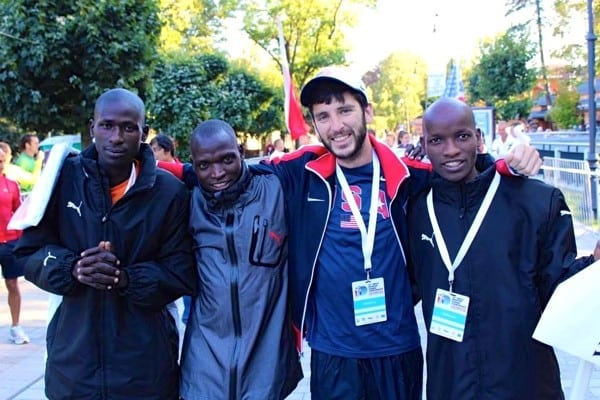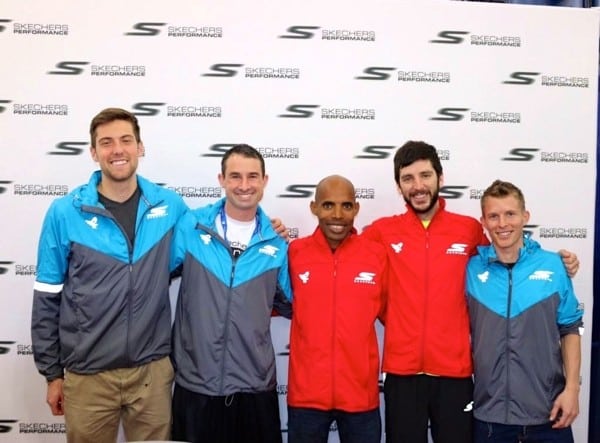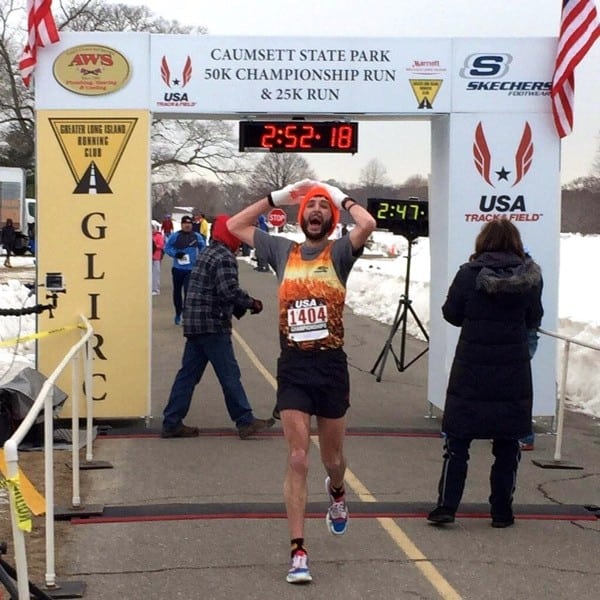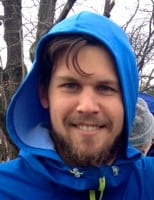Zach Ornelas first showed off his longer-distance speed in winning the 2013 Detroit Marathon with a time of 2:20:11 in his first attempt at the distance. The former University of Michigan runner moved onto ultra distances the next year and quickly evidenced his considerable potential for success in finishing sixth at the 2014 Cayuga Trail 50 Mile, which served as the USATF 50 Mile Trail National Championship, and in again finishing sixth among a stacked field at the 2014 Flagline Trail Fest, the USATF 50k Trail National Championship. But his potential was not more fully realized until his most recent ultra performance: Ornelas mastered the 10-loop Caumsett 50k course to become the 2015 USATF 50k Road National Champion. His pace of just over 5:30 per mile resulted in a 2:52:17 finishing time—the sixth-fastest 50k time by a North American and just two minutes slower than the second-fastest time.
Ornelas’s performance at Caumsett is indicative of some rather remarkable potential at ultramarathon distances—potential that has only partially been realized so far. How did he achieve such a standout performance? What does he think about his past ultra performances? What are his goals for the rest of the 2015 season and beyond? Read on!
iRunFar: Zach, let’s talk about your background. You went to the University of Michigan; when did you graduate?
Zach Ornelas: I graduated in December [2013]. Four and a half years. I was finishing up my student teaching.
iRunFar: And you ran at Michigan?
Ornelas: I did, yeah. I ran four years. I didn’t have eligibility for my last semester so I was training for the marathon then.
iRunFar: Right. What about running accolades in college?
Ornelas: I was okay. I was always top five for the team. We had some pretty good teams. The first few years we weren’t very good but we got better. I ran low 24 [minutes for the 8k], but I never accomplished all the goals I set. I only made the track regional meet one time for the steeplechase. I had some okay performances but I hadn’t hit all my goals in college. I was very much looking forward to longer things—the 5k is too short for me.
iRunFar: And now you teach?
Ornelas: Yeah, I teach. Last year when I graduated, I graduated mid-year and I taught in Detroit for the next six months. Right now I teach at a school that is one-to-one: I teach one student at a time throughout the day. I teach a whole variety of different students. Primarily English but I also teach American history and a little bit of biology.
iRunFar: Where do you live now?
Ornelas: I’m in Ann Arbor, [Michigan]. This is my sixth year here—really cold. We have finally had some sunny days the past few days.

Zach Ornelas training in Ann Arbor, Michigan’s winter. All photos courtesy of Zach Ornelas.
iRunFar: I was looking at your ultrarunning history—you had three races last year. Your Caumsett performance was—it was very fast—and it didn’t seem to line up with your ultra results. [Caumsett] really stood out to me. What about those previous ultras?
Ornelas: Coming out of college I trained for the Detroit Marathon that whole fall and got in 2:20 shape and I feel like I could have run even faster but it being my first marathon I went out running in the 5:0x’s for the beginning—crashed and burned at the end. Shortly after that race—maybe two or three weeks after—I had taken two weeks of nothing, no running, maybe having a little too much fun at the end of my college career. I ended up doing something to my hip. I was out on a run and it almost felt like I tore something. To this day, I still have some lingering hip soreness. I have to get massages when I can and roll it a lot. I think I might have hip-labrum issues.
After that marathon, for six or seven months, it was up and down. I was able to train and run 80 miles a week and then it was down to 30 miles a week because it would just flare up. I lost my consistency. That same season as the marathon I competed for the U.S. in the World Mountain Running Championships, too. I was really at the top of my running performances and then hurt the hip and went way down. I ran [the 2014] Boston Marathon in my third week of training back and exactly one month later was Cayuga, which was to be my first ultra, and that’s not an easy first ultra as I found out. I like the race director there a lot, but it was a tough race. I will return to that in the future—I’m not sure about this summer because I might try for a[n] [Olympic] Trials standard at the half marathon. But my first step into the ultra world I found out that it’s not a flat road race and it’s not a short mountain race. Even though it kicked my butt, I really enjoy it. I’ve told people that I like the idea of getting to the starting line and not knowing if I can finish the race. That’s goal number one: finishing. It’s different from track. I know I can finish a 5k. I might crawl the last few laps but I know it’s no problem—a 5k is real short.
A 50 miles, though, I get to the starting line—I wouldn’t say I’m nervous anymore but when I get to the startling line I have to keep in the back of my mind, Be careful, pay attention to things, don’t do anything dumb because it’s a long race. I got a little bit ahead of myself at The North Face [Endurance Challenge 50 Mile Championships] this past December, going out with some of the big boys who were running some mid-to-low six-minute miles pretty early on. I pulled out of the race at mile 45 with hypothermia. I still have a lot of learning to do in the ultra distance. 50k’s I feel like are going to be my focus for a while, while I still have the marathon strength—I’m still trying to run some fast marathons. But I’m going to run two to three 50 milers a year right now.
I look at a lot of the guys in the sport right now—they’re my heroes. I can’t imagine doing ten 50 milers in a year or doing them on back-to-back weekends. I have a long way to go and have a lot to learn from them. My hydration and fuel plan is slim to none right now. I had four ounces of water at Caumsett. I never train with those things—I really have some work to do there. It was a rough few first ultras. Cayuga I was actually pretty happy with. That course—I hope to not have to run a course any harder than that anytime soon. It was creek crossings and brutal climbs. There was this hill when I was still with the lead pack during the first two hours, [Chris] Vargo ran up it like it was a flat sidewalk. I just remember looking up ahead, mystified: How are they moving this fast up this steep hill right now? Those are things I’m still trying to work into my training. It’s pretty flat where I live but there are some hills. I’m not in the mountains so it’s a little bit harder to get some of that specific training.

Zach and Team Uganda at 2013 World Mountain Running Championships.
iRunFar: Going back to The North Face [race], were you still toward the front when you dropped?
Ornelas: By the time I dropped? No. I started having really bad stomach issues, I’d say at mile 15. At mile 27 or so, around the turnaround, I think I was in 15th place—I started puking. That was pretty far out from the finish line. I started falling back pretty hard. I would have maybe been top 50 but I had fallen back quite a bit. The sport is getting quite fast these days.
iRunFar: You experienced [that speed] at Flagline as well. How did that one go?
Ornelas: I think I went out in the first eight miles there at sub-six[-minute-per-mile] pace with those guys. I remember thinking: I thought this was going to be a lot more relaxed at the start. We were out! I’m not used to altitude and I know it’s not incredibly high out there but I was pretty winded going at that speed on those trails.
iRunFar: I can imagine. Caumsett, then, you might say is more in your wheelhouse—in terms of comfort and experience?
Ornelas: Yeah, definitely. One of the big races I’m looking forward to, maybe next year—I’m not exactly sure, though, because worlds next year for the 50k will be in Qatar and I believe that’s in November and I’m not sure if it will interfere, but [the] JFK [50 Mile] is one that is really intriguing to me. Outside of the first—is it the first six or seven miles that are hilly?
iRunFar: The first 15.5 miles are a mix of trail and pavement, primarily trail. And it’s rolling; a couple climbs, but nothing crazy. Then you get the towpath and the road.
Ornelas: That sounds like something to me—once I get to that towpath, I can just kind of zone out. I’ve always really enjoyed long tempos. Throughout all of college, even if I was having a bad season, I would be up with the top guys or leading all those. I can lock into a pace that isn’t too intense, but I can lock into 5:20s and feel like I can go all day. So that’s going to be—hopefully in the future JFK is the sort of race that is really interesting to me. It’s pretty prestigious—Max King’s performance there is pretty incredible.
iRunFar: The fastest split on the 26.3-mile towpath is actually 2:38, I believe. It sounds like that would be in danger if you got on the towpath and felt decent.
Ornelas: Yeah, my strategy would probably be to relax on the trail and get to the towpath and get moving. I’ll definitely be out there—hopefully some time soon.
iRunFar: Before we talk about the rest of your year—Caumsett. What was your goal going into the race?
Ornelas: Things changed quite a bit in the days leading up [to the race]. Originally I had intended to maybe go for top three because [the] Boston [Marathon] is my big focus for this training cycle—I’d like to be top 25 at Boston, that would be great; I would love [an Olympic] Trials qualifying time but that’s not usually the course to go after one but I’ll be running that pace for as long as I can.
I figured that the competitors going into it—from what I knew about them beforehand—I figured I could run close to three hours, and I knew from my training that three hours wouldn’t be too much of an effort—it would almost be like a tactical 50k and get a really good effort in, like a really long workout; my last really long workout before Boston. Then, in the days leading up [to Caumsett], I started hearing of the guys who were going to be in it: Tyler [Andrews] and Joe Gray, of course—he posted a picture in Times Square and I was like, okay, this is no longer going to be a tactical race. I knew that if I left it to tactical with those guys—I don’t have any form of a kick, whatsoever—I knew they would run away from me.
I kind of had a plan. I knew it was Tyler’s first ultra, so I thought he might take the bait to run fast early and stay with it. I also knew that Joe had raced the weekend before. I figured Joe was looking for an easier start to the race. We started the first lap and my plan off the gun was just to stay relaxed and when I felt that it was time to make I move, I would make a move. At the end of the first [5k] lap, it was still way too slow for my liking. Running a 50k a month out from my big planned race, I knew I wanted to make the best of it and not just jog for too long to pass the miles. So, on the second loop—I think it was the fourth mile—I ran a 5:28 or so, just to see if some people would go with me. I think they kind of looked at me like I didn’t know what I was doing so no one went with me at all. I wasn’t going to just 20-step them for the rest of the race so I put in another surge and ran [the fifth mile] in 5:23 and then 5:23s for the next, maybe, four miles. And that gave me almost a 30- or 40-second lead.
The way the course works is that you do a hairpin turn right before the end of each 5k. We were doing this hairpin turn on this icy section that was all torn up. By doing that by myself, I could control my footing, you know; I could control my foot plants—it was quite bad in that little section. Tyler ended up hurting his hamstring somewhere in the third or fourth loop. The guys behind me had to deal with a lot more traffic on the early loops whereas I was getting out a bit ahead.
Then I told myself—I had never run that fast for that long of a race—Okay, 5:25 [per mile] is what feels really good right now, so slow down a little bit and run 5:25s as long as you can. I just started breaking it up 5k by 5k. I would look at my split midway through [each lap] and I kept seeing 5:25 after 5:25 pop up. I figured that was the comfy mile split for as long as I could go. I didn’t feel tired until maybe mile 27 or so. I told myself, Give yourself a hard effort for two miles and get yourself to 29 and if you have a good-enough lead, you don’t have to worry. I think I ran a couple mid-5:30s maybe upper 5:30s. The last split I had heard, I was five or six minutes in the lead so I was finally able to take some deep breaths. I was still nervous—there were some fantastic runners behind me and I knew if I faltered, I would have some people running me down. I continued to feel good and came across the line, happy to be done. I was starting to get to my limit, but it didn’t feel nearly as tough as my other [ultras] have. It was nice to finish, smiling, knowing I put in a really good effort that day.

Zach with his sponsor, the Skechers Go Elite team.
iRunFar: Were you surprised by your time when you finished?
Ornelas: Not really. Maybe for the conditions. The ice was quite bad—I’ve been running on quite a lot of ice and snow but I know the other runners were really affected by it. In Ann Arbor we have some of the coldest winters in the country. I’ve run in negative 35 Fahrenheit a couple of times here this winter. The ice is almost always a factor. I think I had an advantage there. But knowing what kind of shape I’m in—I’ve been training to run 2:18 for the marathon and I know, I’ve been keeping track of my tempos, one workout in particular. I kept trying to practice goal 50k pace and I thought 5:35 [per mile] pace would be doable and I hadn’t been able to run that on tempos—I’d been running too fast! It was too easy of an effort.
But about a week out from [Caumsett], I ran this kind of famous tempo loop. It’s six-mile loop with a huge hill in the middle—you climb for 1.3 miles. A lot of the old Michigan guys from the 1990s and early 2000s, like Alan Webb, Nick Willis, and people, used to run this loop. There is a lot of history on that loop. I was able to average 5:12 [per mile] on the loop, even with that 1.3-mile uphill in the middle. That’s the best I’ve ever run it and I’ve run it off and on for six years. So, I knew that if I could control myself during the race and not go out like I was running an actual marathon, I could run pretty fast. I was never even looking—the American record is way out there, that’s maybe sometime in the future. But I knew a course record was possible.

Zach Ornelas, 2015 USATF 50k Road National Champion.
iRunFar: Was that one of the faster times ever on that loop?
Ornelas: Not ever because you have those guys like Webb and Willis who used to run it. But it’s one of the fastest times I’ve heard in the last couple years among guys who train out there.
iRunFar: Did you know that your Caumsett time was the sixth-fastest ever by a North American for the 50k?
Ornelas: I did not know that.
iRunFar: Yeah, and it was actually just two minutes slower than the second-fastest time. You’re in pretty elite territory there.
Ornelas: Wow. Well, thank you. I would like to run after some of those times in the future. Caumsett is great but I don’t think it’s the place to run real fast times and chase records—it’s an honest course. The second mile has an uphill; there is a hairpin turn every three miles. I loved it, but it’s not a place I would go to chase after a record.
iRunFar: It sounds like the second-fastest time is definitely in your wheelhouse on a faster course. Did I congratulate you, by the way? Congratulations!
Ornelas: [laughs] Thank you.
iRunFar: As far as fueling goes, you said you had just four ounces of water at Caumsett?
Ornelas: I took a cup of water at one of the aids and drank as much as I could without slowing down. That’s one of the problems I have: when I get into that kind of tempo state, I don’t like too many things to break it up. That’s one of the things I need to practice more. The first marathon I did I had actually been training with water bottles. I have kind of gotten away from that. I realize I need to get back to that because I’ve experienced bonks in the 50 milers and that’s really not fun. I think I only had a gel and a half at [Caumsett]. I just haven’t really mastered that. I don’t take them in my training very often. I’m trying to look for one that works well for me.
I do prefer blocks but the problem is I can’t eat blocks when I’m going any faster than six-minute pace [per mile]. I have a hard time doing that. I’m trying to look for some kind of nutrition that will help. It might have made me feel a bit stronger but I do realize it’s a dumb thing to do in a race like that [laughs].
iRunFar: Let’s talk about the future. What other ultras are you looking to run this year?
Ornelas: My biggest focus is to get [an Olympic] Trials time for the marathon. That’s been a dream of mine, probably since middle school: to be on the Trials line. Also, it would be nice because I could finally focus a lot more on the trails. A lot of next year, if I do get that time, will be to get to the starting line in L.A. [for the Olympic Marathon Trials] so that I can have my best race there. But that would give me a couple of years to focus on these big trail races that I would like to do but that conflict. In the fall, you choose a marathon to focus on and I probably won’t have to do that after the Trials. I can do these big fall ultras. And then in the summer, instead of worrying about messing up my base for the marathon, I can do these bigger 50 milers and 50k’s in the mountains. I can go out to Colorado—my parents live out in Colorado.
For the rest of the year, Boston will be next month. I’m actually looking at—you’ll have to tell me the name of it. The 50 miler in May that’s in Wisconsin—is that Ice Age?
iRunFar: Yes, that’s the Ice Age Trail 50 Mile.
Ornelas: I’m looking at Ice Age because I know it’s a little bit flatter. From everything I’ve read it gets cooking early in that race and that’s more up my alley for a 50 miler right now. I’m looking at Ice Age, will probably end up on that start line [Author’s Note: Ornelas has since confirmed via email that he is signed up for Ice Age and JFK.]. Then, the Grandma’s Half Marathon in June. And then the [USA] Mountain [Running] Championships in July, which will just be a shoot out this year.
iRunFar: Where is it this year?
Ornelas: Bend, [Oregon], and designed by Max King.
iRunFar: Is it an up-and-down year?
Ornelas: Yeah, it’s an up-down year.
iRunFar: That will be exciting. It was great talking with you. Best of luck in your races the rest of this year—I’ll look forward to seeing how you do.
Ornelas: Thank you, thanks for the interview.
